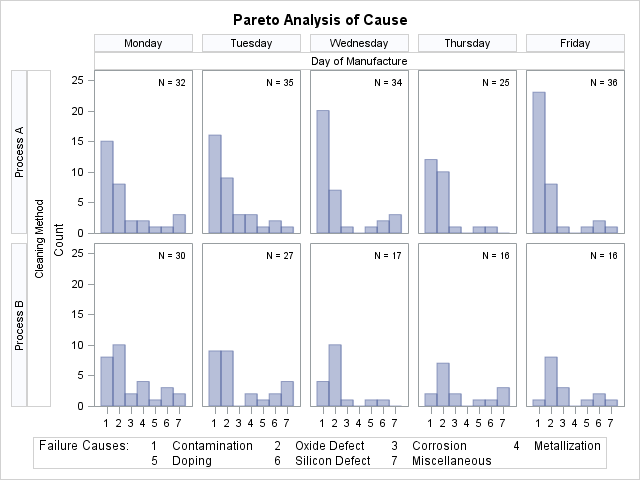The PARETO Procedure
- Overview
-
Getting Started

-
Syntax

-
Details

-
Examples
 Creating Before-and-After Pareto ChartsCreating Two-Way Comparative Pareto ChartsHighlighting the "Vital Few"Highlighting Combinations of CategoriesHighlighting Combinations of CellsOrdering Rows and Columns in a Comparative Pareto ChartMerging Columns in a Comparative Pareto ChartCreating Weighted Pareto ChartsCreating Alternative Pareto ChartsCustomizing Inset Labels and Formatting ValuesSpecifying Inset Headers and PositionsManaging a Large Number of Categories
Creating Before-and-After Pareto ChartsCreating Two-Way Comparative Pareto ChartsHighlighting the "Vital Few"Highlighting Combinations of CategoriesHighlighting Combinations of CellsOrdering Rows and Columns in a Comparative Pareto ChartMerging Columns in a Comparative Pareto ChartCreating Weighted Pareto ChartsCreating Alternative Pareto ChartsCustomizing Inset Labels and Formatting ValuesSpecifying Inset Headers and PositionsManaging a Large Number of Categories - References
Note: See Ordering Rows and Columns in a Comparative Chart in the SAS/QC Sample Library.
This example illustrates methods for controlling the order of rows and columns in a comparative Pareto chart.
The following statements create a data set named Failure5:
proc format;
value procfmt 1 = 'Process A'
2 = 'Process B';
value dayfmt 1 = 'Monday'
2 = 'Tuesday'
3 = 'Wednesday'
4 = 'Thursday'
5 = 'Friday';
run;
data Failure5;
length Cause $16;
format Process procfmt. Day dayfmt.;
label Cause = 'Cause of Failure'
Process = 'Cleaning Method'
Day = 'Day of Manufacture';
input Process Day Cause $16. Counts @@;
datalines;
1 1 Contamination 15 1 1 Corrosion 2
1 1 Doping 1 1 1 Metallization 2
1 1 Miscellaneous 3 1 1 Oxide Defect 8
1 1 Silicon Defect 1 1 2 Contamination 16
1 2 Corrosion 3 1 2 Doping 1
1 2 Metallization 3 1 2 Miscellaneous 1
1 2 Oxide Defect 9 1 2 Silicon Defect 2
1 3 Contamination 20 1 3 Corrosion 1
1 3 Doping 1 1 3 Metallization 0
1 3 Miscellaneous 3 1 3 Oxide Defect 7
1 3 Silicon Defect 2 1 4 Contamination 12
1 4 Corrosion 1 1 4 Doping 1
1 4 Metallization 0 1 4 Miscellaneous 0
1 4 Oxide Defect 10 1 4 Silicon Defect 1
1 5 Contamination 23 1 5 Corrosion 1
1 5 Doping 1 1 5 Metallization 0
1 5 Miscellaneous 1 1 5 Oxide Defect 8
1 5 Silicon Defect 2 2 1 Contamination 8
2 1 Corrosion 2 2 1 Doping 1
2 1 Metallization 4 2 1 Miscellaneous 2
2 1 Oxide Defect 10 2 1 Silicon Defect 3
2 2 Contamination 9 2 2 Corrosion 0
2 2 Doping 1 2 2 Metallization 2
2 2 Miscellaneous 4 2 2 Oxide Defect 9
2 2 Silicon Defect 2 2 3 Contamination 4
2 3 Corrosion 1 2 3 Doping 1
2 3 Metallization 0 2 3 Miscellaneous 0
2 3 Oxide Defect 10 2 3 Silicon Defect 1
2 4 Contamination 2 2 4 Corrosion 2
2 4 Doping 1 2 4 Metallization 0
2 4 Miscellaneous 3 2 4 Oxide Defect 7
2 4 Silicon Defect 1 2 5 Contamination 1
2 5 Corrosion 3 2 5 Doping 1
2 5 Metallization 0 2 5 Miscellaneous 1
2 5 Oxide Defect 8 2 5 Silicon Defect 2
;
Note that Failure5 is similar to the data set Failure4, which is created in Example 15.2. Here, the classification variables Process and Day are numeric formatted variables, and the formatted values of Day are Monday through Friday. In Example 15.2, Process and Day are character variables, and the values of Day are 'March 1' through 'March 5'.
The following statements create a two-way comparative Pareto chart for Cause; in this chart the rows represent levels of Process, and the columns represent levels of Day:
title 'Pareto Analysis by Process and Day';
proc pareto data=Failure5;
vbar Cause / class = ( Process Day )
freq = Counts
nrows = 2
ncols = 5
last = 'Miscellaneous'
scale = count
catleglabel = 'Failure Causes:'
nocatlabel
nocurve
nlegend;
run;
The chart is shown in Output 15.6.1. The levels of the classification variables are determined by their formatted values. The default order in which the rows and columns are displayed is determined by the internal values of the classification variables, and consequently the columns appear in the order of the days of the week.
If Day had been defined as a character variable with values Monday through Friday, the columns in Output 15.6.1 would have appeared in alphabetical order.
You can override the default order by specifying the ORDER1= or ORDER2= option (or both).
